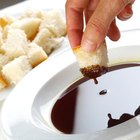
Fat delivers flavor. Cooking oil flavors food by coating ingredients, adding richness and using heat to transform proteins and vegetables. Seasoning oil imparts its own distinctive flavor to a cooked dish. Peanut oil holds up well to high heat, making it an appropriate choice for cooking techniques such as stir-frying and deep-frying. Sesame oil seasons ingredients, even when you just cook it lightly.
Smoke Points
Peanut oil works well in stir-fries and for deep-frying because of its high smoke point. When cooking oil reaches a temperature hot enough to smoke, it develops unhealthy free radicals, an unpleasant odor and a burnt flavor. Toasted sesame oil has a very low smoke point. Add it at the very end of a cooking process to enjoy its flavor while still preparing a healthy dish. Unrefined sesame oil has a higher smoke point than toasted sesame oil, so it works for high-heat cooking.
Oil and Flavor
The sesame oil typically used to flavor stir-fries and soups comes from toasted sesame seeds, which provide a rich, nutty flavor characteristic of Chinese, Japanese and Korean cuisines. Peanut oil typically sold in American supermarkets has a neutral flavor, allowing it to take a back seat and let other flavors such as soy sauce, ginger and sesame oil feature more prominently.
Oil and Stir-Frying
Stir-frying cooks ingredients quickly on high heat, usually in a wok or large saute pan. Ingredients are cut into small pieces to ensure rapid cooking. Each piece should be individually coated with peanut oil, so stir-frying typically uses more oil than techniques such as stewing and braising, which incorporate additional liquid and cook ingredients more slowly. Cooks who are skilled at stir-frying also use heat, timing and blanching to avoid using more oil than necessary.
Deep-Frying
Use peanut oil or unrefined sesame oil for deep-frying. Heat the oil to between 350 and 375 degrees Fahrenheit. Test the temperature with a candy thermometer or drop in a small cube of bread to test whether the oil is hot enough to sizzle. Do not use toasted sesame oil for deep-frying.
Oils, Soups and Stews
Toasted sesame oil adds flavor to soups such as hot and sour soup and Asian-style chicken soups. Water-based soup stocks do not reach temperatures hot enough to break down toasted sesame oil, but the oil still retains optimum flavor if you add it at the last minute. Use peanut oil or unrefined sesame oil to saute soup ingredients such as onion and garlic, or to sear meats before adding them to soup broth.
Related Articles

What is Rapeseed Oil?

Substitutes for Walnut Oil

How to Roast Whole Flounder
How Long Can You Keep and Reuse Peanut ...

What Kind of Oil Should I Use to ...

How to Make Tortilla Soup

The Shelf Life of Pumpkin Seed Oil

How to Add Citric Acid to Castile Soap

Cooking Oils With Low Smell
Cooking With Camellia Oil

How Many Calories Are in Garlic Chicken ...

How to Make Celery Soup

How to Make Warming Body Oil

How to Cook French-Fried Turnips

How to Deep-Fry Chicken Nuggets

What Type of Oil Can I Use to Deep Fry ...

How to Make Homemade Green Tea ...
4 Healthy Dinner Ideas for Weight Loss

Almond Oil Cooking Substitution

Recipes for Enameled Cast Iron Cookery
References
Writer Bio
Devra Gartenstein is a self-taught professional cook who has authored two cookbooks: "The Accidental Vegan", and "Local Bounty: Seasonal Vegan Recipes". She founded Patty Pan Cooperative, Seattle's oldest farmers market concession, and teaches regular cooking classes.
Photo Credits
Hemera Technologies/PhotoObjects.net/Getty Images